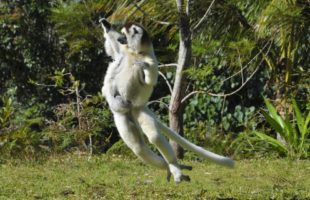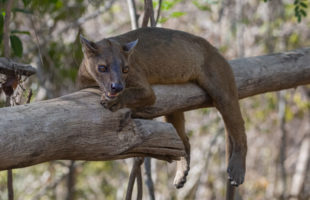In an incredibly hot, dry and inaccessible area in north-eastern Madagascar live white lemurs, which owe their name to the golden fur on their heads: the Golden Crowned Sifakas (Propithecus tattersalli). The secret kings of the north reach a height of just 95 cm with a weight of 3.5 kg, whereby still further 45 cm of tail come in addition. …
LesenSchlagwort-Archiv: dry forest
No life without the Ocotillo: Verreaux’ Sifakas
The Verreaux’ Sifakas (Propithecus verreauxi) lives in the south of Madagascar and belongs to the few lemurs that successfully colonize the hot and hostile spiny forests. It is a very adaptable species that can survive even in very small forest areas. It can even be found in some lowland rainforests in the southeast of the eighth continent. In the northwest, the …
LesenThe last nomads
Madagascar has many different ethnic groups, and most of them still have original lifestyles, ancient traditions and centuries of deep-rooted faith. But a small group of Madagascans live even closer to nature and the lives of their ancestors: The Mikea, Madagascar’s last nomads. The small ethnic group of about 1000 people gets its name from the forest of the same …
LesenAnja Community Reserve
Anja Community Reserve: The reserve is named after the Anja Miray Association, its nickname is “Anja Park”. Because of its rocky character, the reserve is also known as “Rocky Park”. Location: About 13 km south of Ambalavao is the Anja Community Reserve in the Haute-Matsiatra region. It can be easily reached by car via the RN7, it is only half …
LesenProtected area Loky Manambato
Loky Manambato: This reserve is named after the two rivers that flow through it: Loky and Manambato. It is home to the last lemurs of its kind. In this remote part of Madagascar, you are rewarded with fantastic photo opportunities and unique experiences that may not be possible anymore in a few years. Location: Daraina, a small village directly within …
LesenTsingy de Bemaraha National Park
Tsingy de Bemaraha: Mitsingytsingyna is the Malagasy term for “walking on tiptoe” and gives its name to the needle-pointed rocks that make up the National Park. Location: Tsingy de Bemaraha National Park is located in western Madagascar in the Melaky region. It is about 250 km north of Morondava, from where taxis run to the National Park. However, an off-road …
LesenLemurs, the spirits of the forest
Lemurs are probably Madagascar’s most famous mammals – not for nothing because they originally exist only there and nowhere else in the world. They belong to the strepsirrhine primates and are divided into about 100 different species. The word lemures comes from Latin and refers to the spirits of the dead of ancient Rome, who have little resemblance to the …
LesenAn extraordinary predator: The Fossa
Indeed it looks a little strange: The Fossa (Cryptoprocta ferox). The long-stretched body wears a thick tail of almost equal length, and the cat-like head is graced by quite sharp teeth and a big, round nose. And although the Fossa grows only knee-high, it is Madagascar’s largest predator. Both genders reach a maximum body weight of 12 kg, the males …
LesenAnkarana Special Reserve
Ankarana: Ankara is derived from the name of the population living there, the Antankarana. Antankarana means “the people from the rocks”, which refers to the Tsingys typical for the special reserve. Location: Ankarana is located on the RN6, just 110 km south of Antsiranana (Diego Suarez) and about 35 km north of Ambilobe, in northern Madagascar. The reserve is only …
LesenIsalo National Park
Isalo: Isalo National Park is located in the southern highlands of Madagascar in a breathtaking mountain landscape of craggy rocks and dazzling mountains in all colours of the rainbow. Location: Isalo National Park is located on the RN7 in the south of Madagascar in the province of Ihorombe. It is about halfway between the coastal city of Toliara (Tuléar, about …
Lesen MADAMAGAZINE Your Magazine about Madagascar
MADAMAGAZINE Your Magazine about Madagascar










